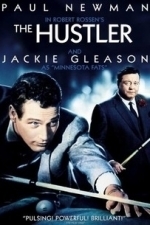"Then the next Paul Newman film has to be The Hustler — that’s as much about directing as anything else. I know that director [Robert Rossen] didn’t do a ton of stuff but that’s the first time I really started thinking about the frame. That’s not true; I thought about the frame before I even knew I was thinking about the frame when I saw Lawrence of Arabia. I saw The Hustler again on a film print in college. I’d seen it many times before, I actually owned it on video in high school. What high school student owns a video cassette of The Hustler? But I did. I just thought it was so beautiful — that black and white photography. The framing in that film — I think it’s cinema scope. I know it’s 235, so super wide frames.
The way they would stack foreground-background action in that — that was a real lesson because I had done this thing in my first video project in film school. I was looking at the camera and I was looking at the shot and it was a video camera that they had on a little pee-wee dolly that had a hydraulic boom arm on it. I was just sitting there looking at this video and wondering, “This is in my infancy as a person thinking about visual storytelling.” I was messing with this hydraulic boom lift and looking at the monitor and all of a sudden I lowered the camera to the point to where this table that was right in front of the camera fell into the foreground. Then I had this thing in the foreground and this carriage in the background. And all of a sudden, it just got vastly more interesting to me. I know that might seem so remedial to people that take photographs and other things. This was a big breakthrough for me.
When I went back and looked at The Hustler you see all of this complex foreground-background framing going on. Spielberg‘s the best at it too. Spielberg does it all the time. If you look at scenes in Indiana Jones where they’re sitting across the table the more he puts the camera — it’s awesome. But there’s an elegance to the camera placement and the camera movement in The Hustler that’s pretty undeniable.
Not to mention, there’s a reason I’m talking about Paul Newman movies: there’s a behavior emerging in these films from the sixties that I really identified with. I almost felt like they valued it more than people in other decades, because they were so directly breaking free from the structures of studio films of the fifties and that acting style, more importantly. That it seemed like, “Now we’re going to take some seriously flawed characters for a run, for a test drive.” It’s when you start getting, I think, some of the best writing in film history — and character writing specifically. Stories that turn on character more than plot. What an odd plot for The Hustler. What an odd trajectory, but totally compelling. When I guess they’re going to the derby or whatever and that’s when his girlfriend — what an odd structure. That’s really something I strive for in my stuff. Structures that aren’t just a continual execution of plot, but are really driven by characters and their flaws."
Source









